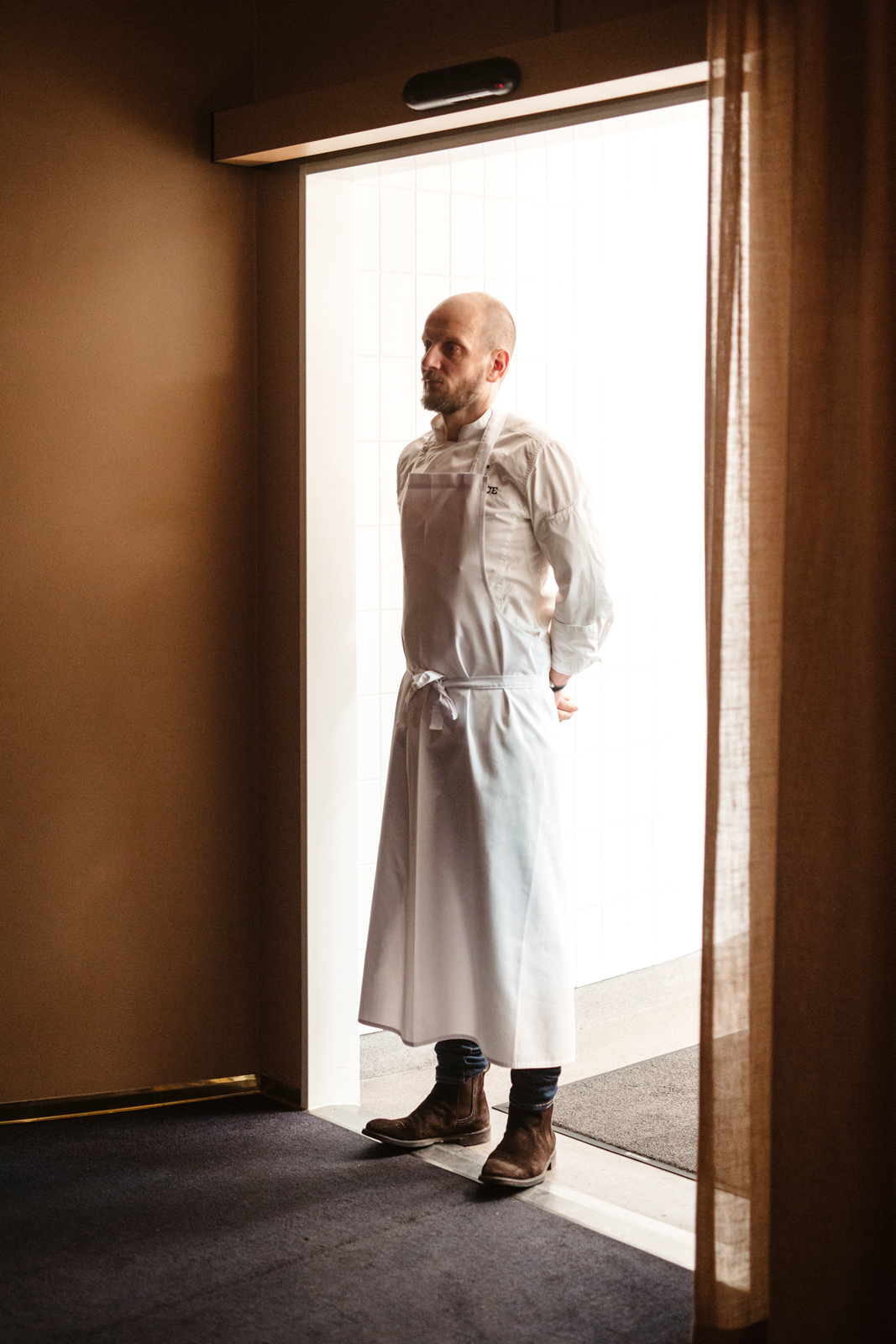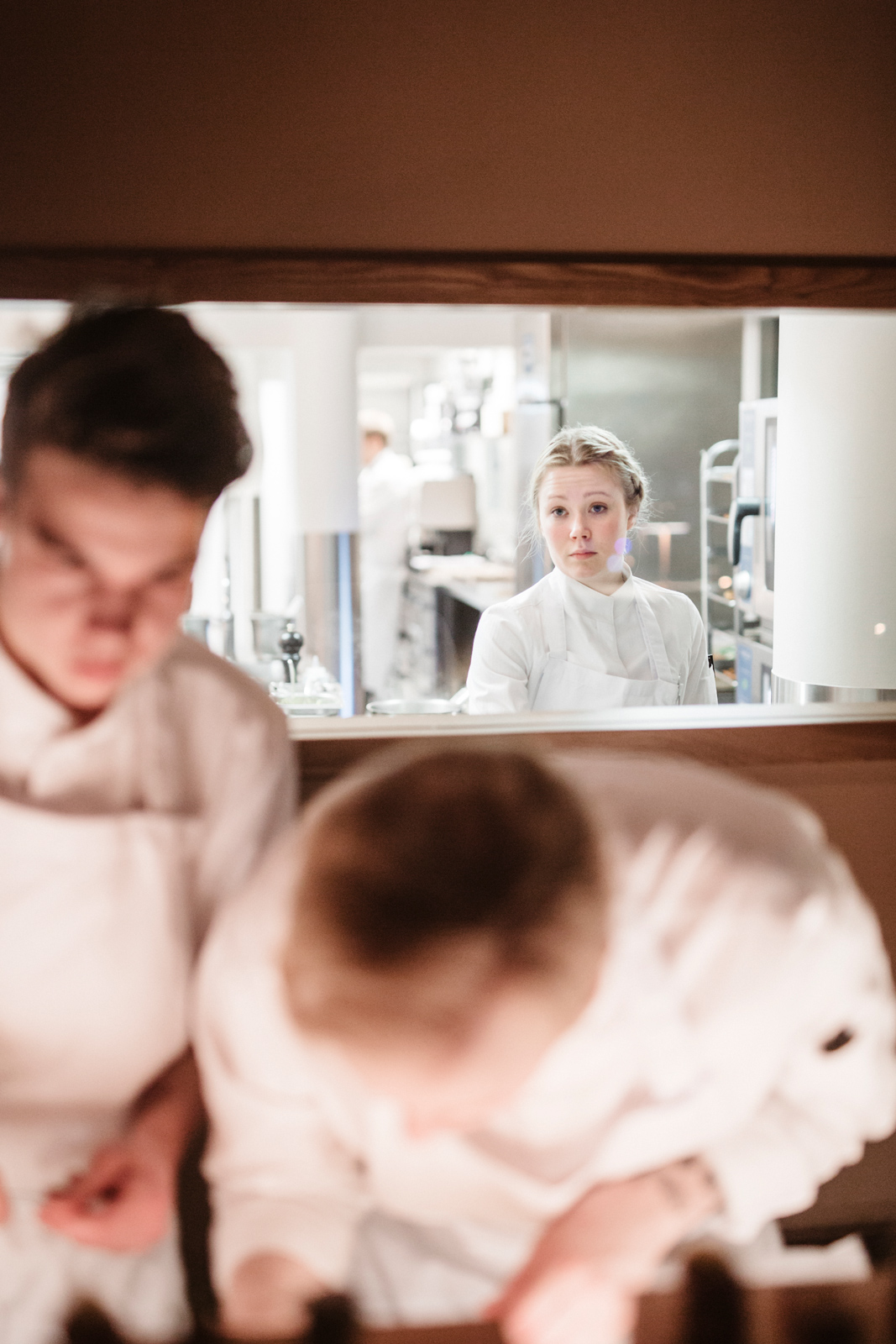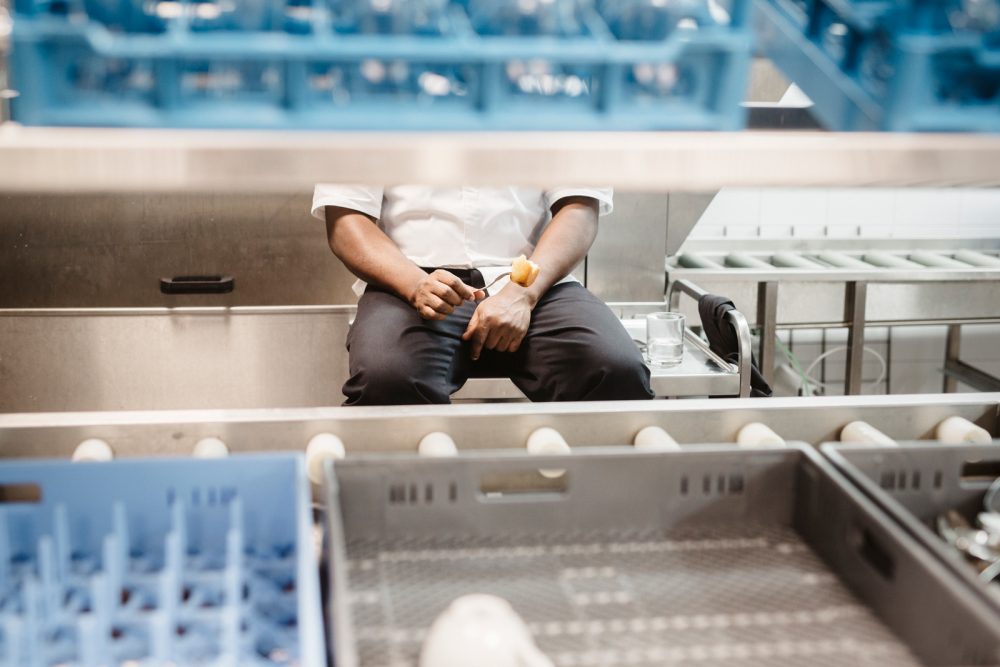
A hulking monolith sits in Helsinki’s South Harbor, a stone’s throw from the city’s neoclassical center. Precast concrete elements make up the facade, along with rows upon rows of windows that encircle the building like glass train tracks.
This is Eteläranta 10, some of the Finnish capital’s most coveted real estate.
The Confederation of Finnish Industries holds court behind the glumly glittering walls; this business collective represents a lion’s share of Finland’s entire economy, which is why many Finns have seen their headquarters on the news. But not many have ventured in – or up, rather.
An elevator ride takes us soaring to the tenth floor, where the view offers a direct line of sight to some distinguished edifices and signs of bustling commerce. The Baltic Sea gleams directly in front, accented by a 90-meter crude oil tanker and the Katajanokka Ferris wheel on the opposite shore. To the left along the distant Kanavaranta area we can espy the waffle-like Stora Enso forestry firm HQ and its famous windows. The city’s cathedrals and mansions all glint in the gloom, the street lamps like candles.
All you need now is a glass of pricey champagne, and you can pretend to be an early 20th (or indeed 21st) century industrialist surveying their prospects. It’s way up here that the well-to-do also come to dine.
Finland’s most famous cookery star, Hans Välimäki, looks a little upset. His brow furrows just like it does on all of his TV shows: Top Chef Suomi, Hansin grillibileet, Hansin matkassa, Haasta Hans, Kokkisota, and so on.
Välimäki is the chef at Palace, a high class restaurant with a history of catering to tycoons and whipping up master chefs-to-be. It was the first establishment in Finland to ever receive a Michelin star in 1987.
Thirty years later, on this Friday in February, Välimäki just has time to sip his macchiato and answer some questions. His sombre appearance has less to do with an overcooked roast or uninspired sauce, and everything to do with money.
After the Palace reopened following a year-long renovation last November, the first thing the press made note of were the prices: a 17-course dinner menu costs 169 euros, and the house’s wine list will run a table anywhere between 230 euros and a staggering 1,200 euros.
That’s way more than any of Finland’s five other Michelin businesses charge; most customers get by with a hundred-euro dinner menu, double that with drinks. Daily Helsingin Sanomat ran an article in its Nyt supplement calling Palace Finland’s most expensive restaurant of all time.
Boss Välimäki disagrees.
”Depends what you’re comparing it to,” he says.
”Our menus come in at just under 10 euros per course, and the wine ensembles are for large parties.”
Välimäki launches into a presentation on Palace prices. The menu clearly shows that only the most superlative of ingredients and meals are allowed here in the dizzying culinary heights. No trendy local food or self-picked wild herbs here; the global jet set is all about caviar, Italian truffles, quail’s eggs, and fattened delicacies such as Challans duck.
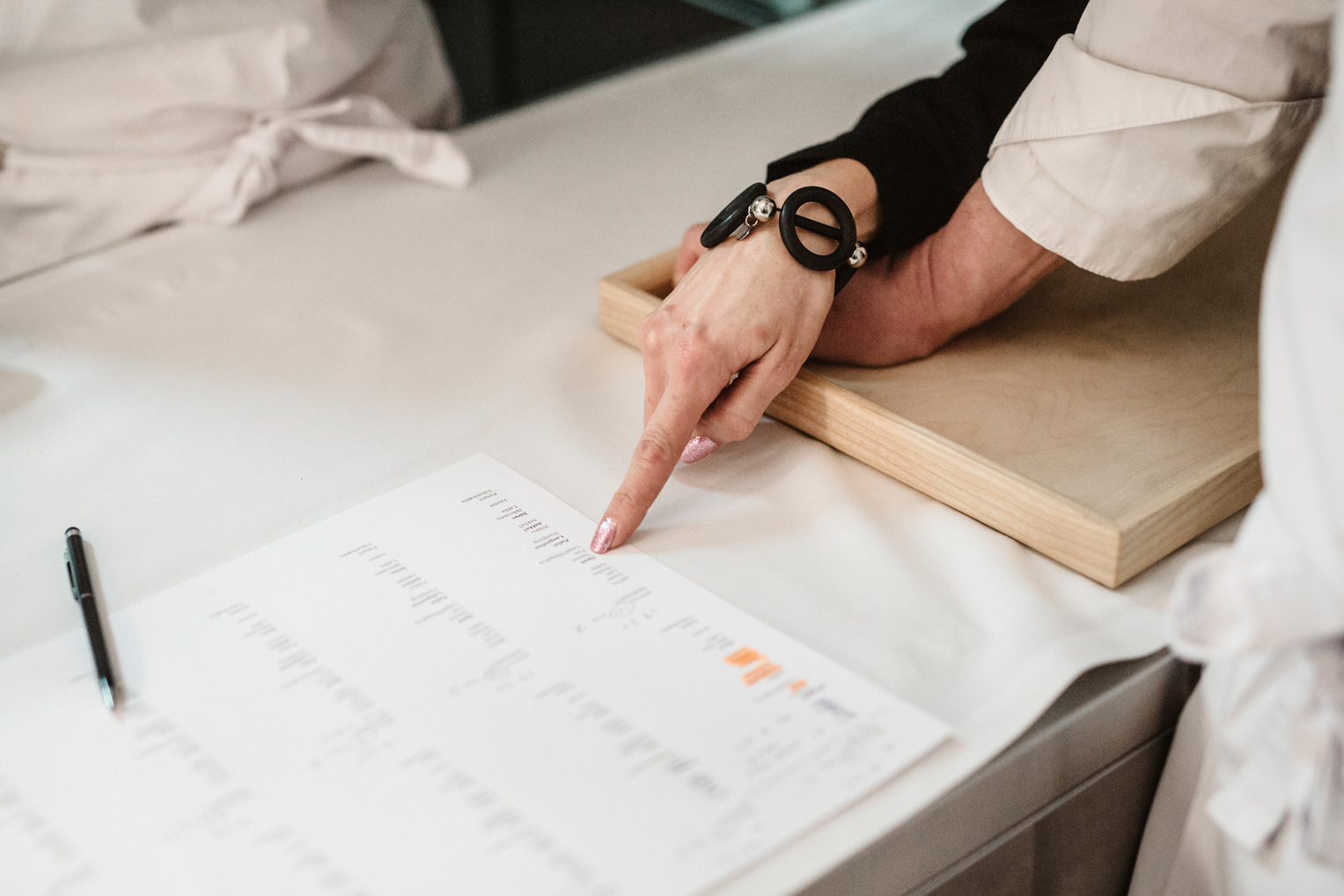
On the kitchen table there is an A3-sized list containing the starting times of reservations, the number of people per table, special diets, and other preferences. The most crucial details are marked in orange highlighter.
Table 3: two non-dairy portions. Table 5: no mushrooms. One celiac diner, one birthday party. The cake is on the house.
Tonight all twelve tables are reserved, each for a single party for the whole night, coming in at 32 customers.
The first reservations begin at 6:30 pm. It’s just after five, so there’s time for a trip down memory lane.
Palace has always been both seemingly and actually off-limits to the hoi polloi. It was constructed as a luxurious hotel and restaurant for the Helsinki Olympics in 1952, when postwar Finland took a big international step towards a brighter era. Armi Kuusela was crowned Miss Universe, Coca-Cola and hamburgers hit Finnish markets, and the last train carrying war reparation deliveries crossed the border of the Soviet Union wreathed in conifer branches.
Dining out was rare. Some of the true delicacies of the following years included fare now considered downscale, such as the Hawaiian schnitzel (complete with pineapple slice) and Dole brand canned peaches.
Palace is known as the purview of businessmen and manufacturers, because nestled in the same building are organizations such as the aforementioned Confederation of Finnish Industries, Technology Industries of Finland, and the Finnish Commerce Federation. All the glamorous and hackneyed tropes are true: heated collective agreement battles and trade negotiations followed by long, boozy, cigar-smokey lunches that morph organically into sauna bathing and late dinners.
The carpets of the ninth floor’s now shuttered Palace Hotel have felt the soles of Swedish and British royalty, the members of the Rolling Stones, actor Marlon Brando, and other megacelebrities.
The hotel closed down in 2009, but the restaurant stayed. When last year the new owner announced it would reopen the Palace kitchen, it was clear that the restaurant’s rise back to the top of all the charts would be in their sights.
The Royal Ravintolat concern hired a domestic culinary dream team: Välimäki was joined by Eero Vottonen, who represented Finland in the Bocuse d’Or world chef championships last year. He is also literally the Chef’s Chef, according to the Finnish Gastronomic Academy.
Next on the roster were sommeliers Juha Lihtonen (multiple Finnish champion and once in the world top 10) and Riina Nissinen, who was newer to the game but had already poured wine in glitzy restaurants such as the Savoy and Finnjäveln.
The buildup to the opening night was breathless. A special farmer’s market at the Old Student House gathered together top food producers from around the country to show off their ingredients to professional restauranteurs. Finnish fine dining was hailed as ”pioneering” in a slew of interviews. Välimäki told and retold the press a story about how he had hung around outside Palace inspecting its menus as a young chef, and how he once ate a seven-course meal prepared by Markus Maulavirta just to know what a masterful culinary experience tasted like.
His colleague, champion chef Vottonen is off shift tonight, minding his kids.
The radio plays a Pussycat Dolls song in the kitchen, someone’s humming along. It’s time to start the evening.
The kitchen is shaped like a U and encircled with tabletops and a stove. Heat lamps hang above the table to keep orders from cooling down. Behind these a handful of chefs are busying themselves. They’re twenty-something greenhorns, but they might end up being the next masters of the art if Välimäki and Vottonen have their way.
Next to the kitchen is a larger space for creating the specific meals and desserts for the private dining rooms and the banquet hall. Downstairs there’s even a small dedicated bakery.
The evening shift workers have arrived before noon. Before the meals are served the employees share a modest lunch of frankfurters and mashed potato, prepared in the Palace kitchen. They have also been preparing their tools and ingredients, known as mise en place, French for getting things in shape. Today they’ve been mixing the crab butter, simmering the stews, and shelling lobster tails.
This is the part where everything is double checked. Are the work spaces in order, are the trout sauces in bottles, the celery-carrot biscuits in plastic boxes, the pickled mustard seeds in their drawers? When it’s go time, every single ingredient needs to be on hand in the blink of an eye.
The last plates are being buffed with water and spirit vinegar – an old trick that removes finger grease, used by grandmothers the world over.
”Who’s eaten all my lozenges?” chef Anni Peräkylä asks the room.
Peräkylä is 20 years old and off to a brisk start in her career. Last year she won the cooking championship organized by Finnish culinary schools, graduated from the Turku Vocational Institute, and met Eero Vottonen in the kitchen of local street food eatery Storage. When Vottonen asked Peräkylä to join him at Palace, she packed a bag and moved to Helsinki without batting an eye.
Tonight she’s in charge of three ensembles of entrées. One of them is about to make its way to a table: Atlantic halibut and Granny Smith apple paste assembled into lime green rosettes that are as delicately see-through as steamed up sauna windows. The rolls are served with yoghurt flavored with fresh oysters.
Peräkylä is the only woman on the haute side of the kitchen, and women are underrepresented in the industry as a whole. The notion of world-class gastronomy being a masculine calling has been cemented by loudmouthed TV tough guys like Gordon Ramsay and anti-vegan cooking personality Anthony Bourdain, whose book from 2000 likened professional kitchens to pirate galleons fuelled by whiskey and cocaine. Last October Savoy chef Kari Aihinen controversially blew his top on a popular Yle television show, claiming that ”laws of physics” such as childbearing preclude women from making it big in the food biz.
Peräkylä smirks.
”I don’t think gender is an issue. There’s an almost military hierarchy in the kitchen, but you don’t foster respect by cussing everyone out. Men have to pick up children from daycare, too.”
- Hans Välimäki
- Anni Peräkylä
Yet another Palace creation sits on a wooden tray. Here, even bread is not mere bread: this is gluten-free potato flatbread, flavored with buckwheat and sourmilk, touched with some sautéed butter. Next to it are pickled onion, spruce sprouts, and cream cheese decorated with a powdered shoot of garlic. The bread plate is finished off with air-dried slivers of pork rib, which used to belong to a wooly Mangalica pig, famed for its fatty, marble-patterned meat.
Top chefs are almost mythical figures in today’s job market. Just a few decades ago restaurant employees were viewed with such bitter suspicion that they often had trouble renting apartments. Irregular shifts and a workplace culture of hearty parties helped feed the impression of chefs and servers as drunken night owls.
But then the airwaves started churning out cooking show after cooking show, and chefs became superheroes by whose hand water turned into vinaigrette.
Very soon, however, public talk turned to probematic issues: vainglorious teens filling up cooking classes seeking their 15 minutes of fame, trained chefs ending up in fast food joints, the crappy hours, and the barely average pay.
TV chef Henri Alén said in the monthly supplement of Helsingin Sanomat that a chef who takes care of their physical health can expect their gourmet career to last until about age 45.
In 2013 Välimäki’s Chez Dominique, then the country’s number one restaurant, was embroiled in a scandal. The restaurant was rumored to have left overtime salaries unpaid and assigned unlawfully long shifts. Välimäki now says that those claims were baseless, but at the time his chef colleagues rushed to defend him by saying that that’s how things work in pretty much every successful restaurant. Athletes don’t complain about rigorous training schedules, they intoned; it’s all for love of the game!
In the last few years the glamour bubble has popped. Applicant figures at cooking schools fell to below the number of spots per semester, many changed professions, and now Finland, too, is in the throes of a chef and waiter shortage. Not that you could tell here on the tenth floor or indeed fine dining establishments generally. Getting into such a shrine of cuisine is like a hockey player being picked for the NHL: a chance to rise through the ranks to be the best of the best, if you stick to the schedule.
Anni Peräkylä has stuck it out. As a student she spent much of her free time at the school frying fillets for cooking contests. Her days as an intern at various restaurants also left their mark.
After Palace, Peräkylä wants to continue her schooling abroad, as ambitious chefs are wont.
”I’d like a restaurant of my own. But sometime in the distant future,” she says.
Fine dining, she means?
”Yeah, something like that.”
Palace cooking shifts can easily last for more than 12 hours. There are no weekend shifts, though, because the place is only open from Tuesday to Friday. Keeping the business closed on Saturdays is good for morale and health.
”That was a story we cooked up for the media,” Välimäki now says, tongue in cheek.
Another explanation is that business leaders keep clear of Eteläranta 10 on the weekends, too.
A waiter steps in through the sliding kitchen door bearing greetings from table 12.
”No visible onions for the gentleman in seat 1. And no mussels or oysters. Except if they’re not visible.”
Shift boss Eero Mäkelä (no relation) is delighted: the oyster yoghurt is a go.
The waiter continues.
”Same table, seat 2, no chili.”
Mäkelä rubs his forehead.
”So the crab stock needs redoing, is there chili in anything else?”
”This guy has a thing about legumes, but he said he’s alright with them now,” replies the waiter.
”But a hard no on the chili.”
In recent years restauranteurs have complained in interviews about how customers used to obediently eat whatever the menu served, and that nowadays everyone seems to have special requests, unrelated to allergies. Vegan, gluten-free, low-carb, slow-absorption FODMAPs… The chefs aim to please, but many wish that customers would inform them about their preferences ahead of time.
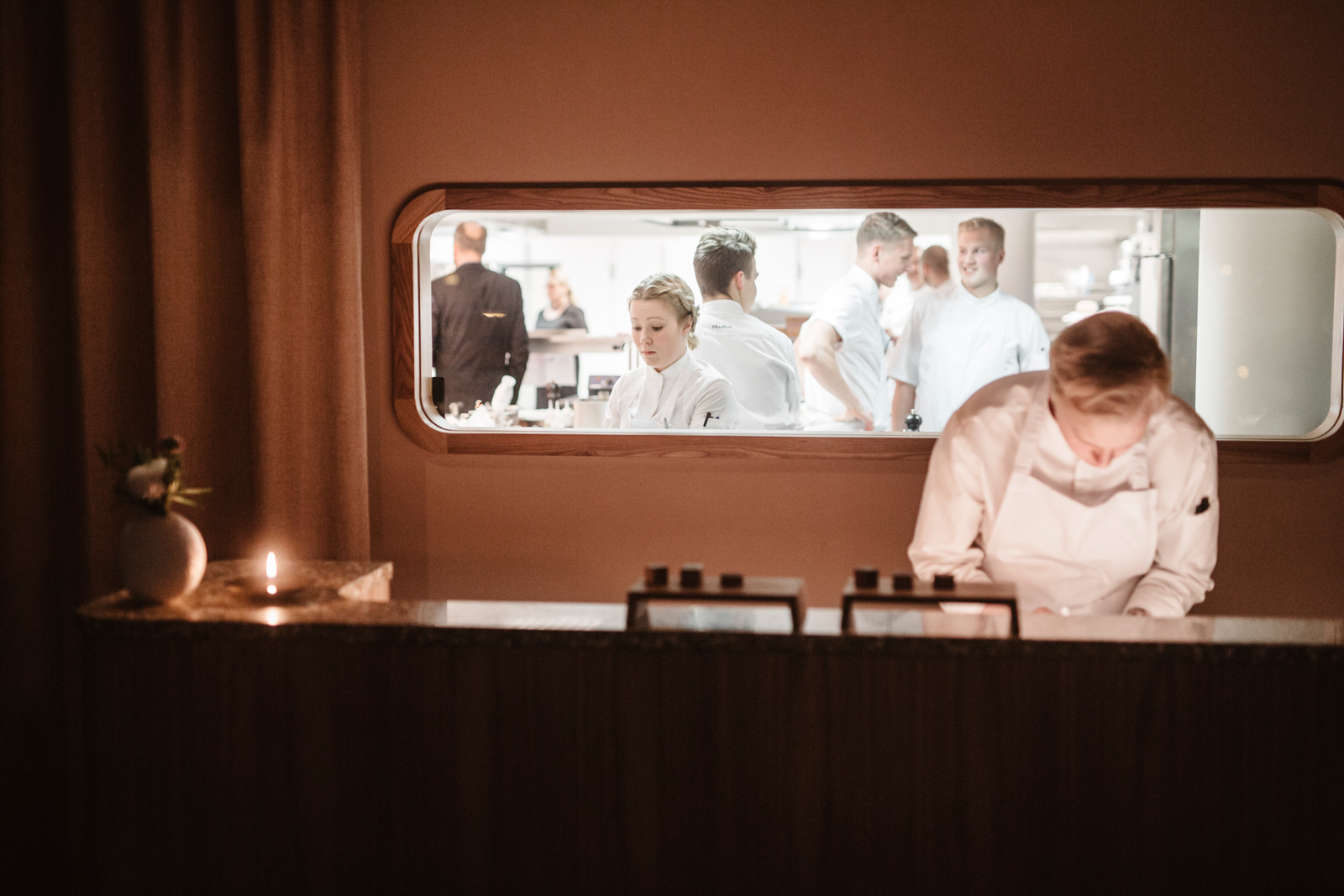
”Let’s really hustle tonight.”
Chef Välimäki stands in the doorway and taps on the table, first with his fingers, then with a black pen sporting the silver Palace logo.
He won’t join the staff in the kitchen, but he is responsible for developing the menu together with cuisinier-in-arms Vottonen. The celebrity chef delivers the servings personally and runs through the ingredients for his hungry customers. The service is included in the hefty cheque.
Occasionally Välimäki has time to check his phone for messages and sports results, joke with staff, taste the sauces, and proffer advice. But nothing like how sneering cooking show judges would.
”This is a good dashi stock, although the salt is pretty overpowering. But it has a good vibe to it.”
Välimäki has been busy in recent times founding a catering company, posing for Lidl ads, and opening restaurants in Helsinki and Tampere. Bistros, burgers, Asian fusion, gastopubs – notably, no fine dining.
Even putting his TV stardom aside, Välimäki is still best known for being the only Finnish restauranteur to have received two Michelin stars. Those were for Chez Dominique back in 2003. Three is the maximum, and makes any establishment an envied international monument.
That third star became a compulsion for Dominique. Items such as liquid nitrogen yoghurt balls started showing up, and Välimäki would work 12-15-hour days and spend his Sundays trying to figure out how to fry milk into crispbread.
To no avail: the third star remained out of reach. The race took its toll, and Chez Dominique closed down some five years ago, depleted of its verve.
Since then Välimäki has been on the fence, saying in some interviews that Palace will not be a new Michelin project, while waxing into reveries of triple stardom in others.
Evening has come, the dim room is candlelit. The background music is a blast from the past, with 80s hits such as Michael Jackson’s Billie Jean, Fleetwood Mac’s Little Lies, and Whitney Houston’s I Wanna Dance With Somebody filtering into the restaurant.
The waitresses are wearing black blouses, skirts, and heels, and their makeup and hair is on point. The waiters are in black suits. The uniform of upper class cocktail parties.
The chefs in the kitchen are a little red in the face, but there’s no rush just now. One of the young chefs is belting out a Finnish reggae song while he cooks.
Fine dining trends come and go. In the 2000s business was booming, companies ran hefty tabs, restaurants conjured up flaming sorbets and forest-scented smoke effects – then came the global crash, and the well ran dry. Futuristic molecular cuisine made way for a return to homier dishes such as dessert porridges and chicken fricassees, even in upscale places. The current thinking is that the best chefs are the ones with the wherewithal to refrain from hiding the basics in magic tricks and a barrage of nuances. Good texture, the right amount of cooking, and the base taste of the ingredients – that’s it.
Let’s take a look at one of Palace’s most commended dishes, the turbot. The stewed fish is served with tiny, hand-made, chickpea-sized potato gnocchi. They are a prime example of the basis of many taste sensations, a chemical phenomenon known as the Maillard reaction.
When the little balls are fried, the heat whips up the sugars and amino acids into a delicate dance, which results in a beautiful golden hue and a panoply of irresistible flavors reminiscent of fresh bread.
Of course, Maillard reactions are common in most home cooking, from a simple piece of toast to searing vegetables on a pan. But in the profession you get sauces that are usually broiled, simmered, flavored, and sieved from bones and veggies into a stock, then into a sauce base, and finally as a finished element in a haute cuisine dish.
The bouquet of flavors is often polished off with monter au beurre, or a generous helping of butter.
The soul of a portion of Palace turbot is fish cream, broiled and flavored with tarragon oil. A dash of pickled onions cleanses the palate. At the table, in front of the seated customers, fresh truffle is grated onto the meal.
”People get pretty excited about that,” Välimäki says.
But gustation, or tasting, isn’t just about what’s going on in the mouth. Other senses can accent and copliment the sensation in diverse ways.
The way food and drink looks has always been important. Even experts can be fooled into thinking that white wine is actually red with a bit of food coloring. When the UK sweets brand Cadbury made the edges of its Dairy Milk bars rounded in 2013, punters started to wonder if the recipe had been made sweeter. That’s because people often associate round, fruitful forms with sugary flavors.
In a corner of the kitchen Anni Peräkylä adds some edible flowers as garnish for her Norway lobsters, because she knows that it reinforces the impression of freshness. Advertising uses motion to imply the same: seductively elastic pizza cheese is the money shot of food porn, the detail that sells them.
Shift supervisor Mäkelä is back with orders.
”Has the foie gras made it to table 1? One beef to 7!”
A sirloin steak of an Australian wagyu cow is set on a plate, which Välimäki takes away. At the table someone will raise a piece of it to their mouth, chew it, and swallow it into their pharynx. That’s where the evaporating molecules of the food rise up into the nasal cavity with each outward breath like smoke from a chimney. Then they attach themselves to the mucous membrane’s olfactory receptors, which deliver a message to the brain, which bundles the sensation together with the signals from the taste buds, and voilà: an experience is born.
Evolution brought our species this ability hundreds of millions of years ago to help us answer a simple question: food, or poison?
Today the questions are different.
Á point or bien cuit?
Translated by Kasper Salonen.


